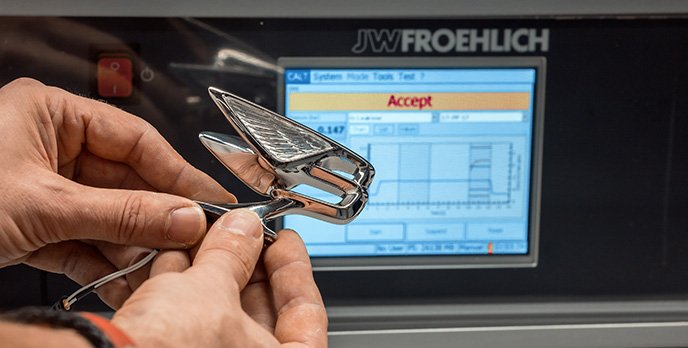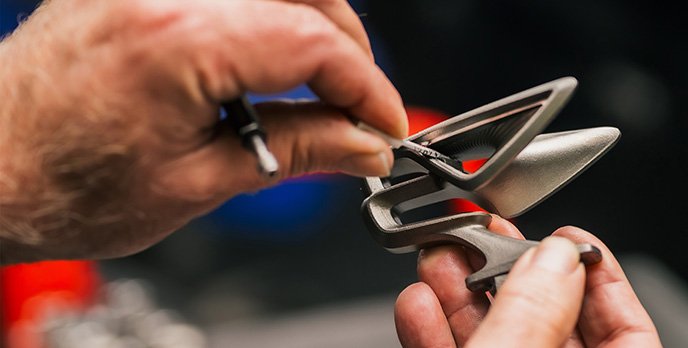Bentley celebrates the newest iteration of the Flying B mascot
22 Nov 2022|812 views
The Bentley 'Flying B' bonnet mascot has had various iterations offered since the 1920s, with the current design being the sixth iteration.
The emblem that graces the radiator of the Flying Spur Mulliner is the first in Bentley's history to be deployed electronically, the first to feature a cover plate that replaces it when stowed, and the first with internally illuminated, clear acrylic wings.
The 'Flying B' mascot is cast as a single piece of 316 grade stainless steel, which has an austenitic crystalline.
This makes it tough and capable of withstanding extreme temperatures.
The addition of molybdenum also gives it corrosion resistance, essential for a component that is exposed to the elements all year round.
The 'Flying B' is made using the investment (lost wax) casting process at Lestercast Ltd, a technique usually reserved for precision components such as gas turbine blades.
This form of casting is used for making complex-shaped components that require tighter tolerances, thinner walls and a better surface finish than can be obtained with sand casting.
The entire process takes 11 weeks from start to finish, at which point the mascot is ready for assembly by WCM Europe Ltd, which works on the crystal acrylic wings, wiring and LEDs that all come together to create a special effect when deployed.
The emblem that graces the radiator of the Flying Spur Mulliner is the first in Bentley's history to be deployed electronically, the first to feature a cover plate that replaces it when stowed, and the first with internally illuminated, clear acrylic wings.
The 'Flying B' mascot is cast as a single piece of 316 grade stainless steel, which has an austenitic crystalline.
This makes it tough and capable of withstanding extreme temperatures.
The addition of molybdenum also gives it corrosion resistance, essential for a component that is exposed to the elements all year round.
The 'Flying B' is made using the investment (lost wax) casting process at Lestercast Ltd, a technique usually reserved for precision components such as gas turbine blades.
This form of casting is used for making complex-shaped components that require tighter tolerances, thinner walls and a better surface finish than can be obtained with sand casting.
The entire process takes 11 weeks from start to finish, at which point the mascot is ready for assembly by WCM Europe Ltd, which works on the crystal acrylic wings, wiring and LEDs that all come together to create a special effect when deployed.
The Bentley 'Flying B' bonnet mascot has had various iterations offered since the 1920s, with the current design being the sixth iteration.
The emblem that graces the radiator of the Flying Spur Mulliner is the first in Bentley's history to be deployed electronically, the first to feature a cover plate that replaces it when stowed, and the first with internally illuminated, clear acrylic wings.
The 'Flying B' mascot is cast as a single piece of 316 grade stainless steel, which has an austenitic crystalline.
This makes it tough and capable of withstanding extreme temperatures.
The addition of molybdenum also gives it corrosion resistance, essential for a component that is exposed to the elements all year round.
The 'Flying B' is made using the investment (lost wax) casting process at Lestercast Ltd, a technique usually reserved for precision components such as gas turbine blades.
This form of casting is used for making complex-shaped components that require tighter tolerances, thinner walls and a better surface finish than can be obtained with sand casting.
The entire process takes 11 weeks from start to finish, at which point the mascot is ready for assembly by WCM Europe Ltd, which works on the crystal acrylic wings, wiring and LEDs that all come together to create a special effect when deployed.
The emblem that graces the radiator of the Flying Spur Mulliner is the first in Bentley's history to be deployed electronically, the first to feature a cover plate that replaces it when stowed, and the first with internally illuminated, clear acrylic wings.
The 'Flying B' mascot is cast as a single piece of 316 grade stainless steel, which has an austenitic crystalline.
This makes it tough and capable of withstanding extreme temperatures.
The addition of molybdenum also gives it corrosion resistance, essential for a component that is exposed to the elements all year round.
The 'Flying B' is made using the investment (lost wax) casting process at Lestercast Ltd, a technique usually reserved for precision components such as gas turbine blades.
This form of casting is used for making complex-shaped components that require tighter tolerances, thinner walls and a better surface finish than can be obtained with sand casting.
The entire process takes 11 weeks from start to finish, at which point the mascot is ready for assembly by WCM Europe Ltd, which works on the crystal acrylic wings, wiring and LEDs that all come together to create a special effect when deployed.
Latest COE Prices
April 2025 | 1st BIDDING
NEXT TENDER: 23 Apr 2025
CAT A$97,724
CAT B$117,899
CAT C$68,782
CAT E$117,002
View Full Results Thank You For Your Subscription.




























